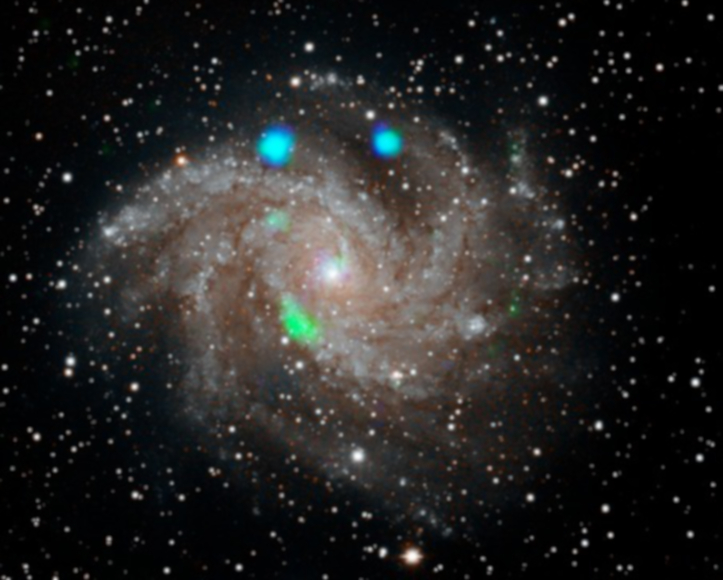
 Credit: NASA/JPL-Caltech/Digital Sky Survey
Credit: NASA/JPL-Caltech/Digital Sky Survey
The Sudden ULX
The most powerful X-ray sources we know of are accreting black holes. These black holes are powered by the accretion of matter from their surroundings. This material might be pulled off a neighboring star by a "small", stellar-mass black hole in a compact binary system, or might be giant clouds of gas, dust and stars swallowed by a supermassive black hole at the center of an active galaxy. In either case, the process is pretty much the same: as material swirls towards the event horizon of the black hole, it forms a hot accretion disk which emits enormous amounts of high energy X-ray radiation. The force of this radiation is so powerful that it can limit the amount of accreting material, and if too much radiation is produced, it acts like a shut-off valve. Thus, there should be a maximum amount of radiation that an accreting black hole system can emit. In recent years, astronomers have identified a mysterious class of objects which have characteristics of accreting compact objects but seem to be much brighter than this limit. These sources are called Ultra-Luminous X-ray sources, or ULXs for short. The nature of these strange sources is not fully understood yet. Some ULXs seem to be accreting neutron stars, where the observed X-rays probably originate from a narrow particle beam from the neutron star. Other ULXs have been suggested to be so-called "intermediate mass" black holes, black holes with masses of a thousand suns or more, perhaps transitional objects between the stellar-mass and supermassive varieties. The image above shows an optical image of the Fireworks galaxy. The bright blue and green dots superimposed on the image show the locations of bright sources of high-energy X-ray emission from ULXs, as seen by the NuSTAR space observatory. The spot shown in green is emission from a surprising source that suddenly appeared during the NuSTAR observations. The nature of the "Green ULX" is not known exactly. Perhaps this sudden brightening is due to the catastrophic accretion of a large quantity of material by a black hole or neutron star. Perhaps a black hole swallowed its companion star?
Published: November 11, 2019
<
HEA Dictionary ● Archive
● Search HEAPOW
● Other Languages
● HEAPOW on Facebook
● Download all Images
● Education ● HEAD
>

Each week the HEASARC
brings you new, exciting and beautiful images from X-ray and Gamma ray
astronomy. Check back each week and be sure to check out the HEAPOW archive!
Page Author: Dr. Michael F. Corcoran
Last modified Tuesday, 27-Feb-2024 10:15:20 EST


